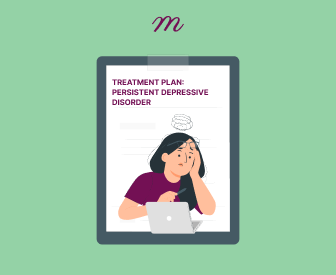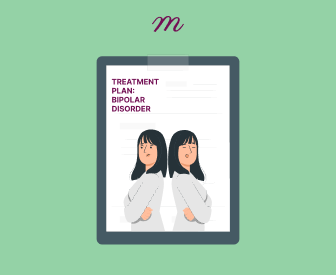Have your progress notes written for you automatically
The American Psychological Association defines Gender Dysphoria as severe distress that occurs when an individual’s gender identity is not the same as the sex they were assigned at birth. Dysphoria can cause a substantial effect on transgender and non-binary people’s mental and social well-being, which is why it is so crucial for mental health treatment professionals to create customized, comprehensive treatment plans aimed at addressing each client’s individual needs.
Whether you have been working with gender-diverse clients throughout your career or are new to this practice, the key to effective support is acceptance, empathy, and a client-centered approach; these are not competency checklists but the core of our daily work. This article will outline the key elements of creating individualized treatment plans for our clients that experience gender dysphoria. We will cover what clients can anticipate of therapeutic care, how to start conversations on medical and social transitioning, and, most importantly, the valuable role every mental health practitioner has to play in affirming their gender-variant clients’ identities.
Treatment Plans for Gender Dysphoria
Gender Dysphoria: Beyond Clinical Definitions
While the American Psychological Association’s definition of gender dysphoria—the distress that arises from a mismatch between an individual’s gender identity and their sex assigned at birth—reflects a clinical perspective, it doesn’t truly capture the profound impact gender dysphoria can have on a person’s life.
Gender dysphoria is not just bodily discomfort but also the hollow feeling of not being recognized as who you are, feeling out of place in your own body. The toll of dysphoria is both mentally exhausting and physically draining. By acknowledging that gender dysphoria is a very personal and diverse experience, we can build an affirming and supportive community that prioritizes individual needs over clinical formalities. This more compassionate model can allow space for genuine, revolutionary change.
A Breath of Fresh Air: Cultivating a Welcoming Therapeutic Space
Therapy isn’t just about treatment; it’s about crafting a refuge where clients can feel comfortable being themselves without fear or judgment. For the majority of transgender individuals, merely existing in public spaces often comes hand in hand with anxiety—misgendering, discrimination, and even threats to their safety. That’s why therapy should never be another space where they must prove or defend themselves. Instead, it should be where they get to breathe. A genuinely welcoming space is one where empathy and acceptance are not just words but the guiding principles of our practice, making our clients feel truly seen and understood.
- Names and pronouns are powerful. They’re not just labels; they resonate with identity. Using the right ones from the start is not just a simple way to show respect but a profound way to affirm your client’s identity and make them feel valued.
- Never make assumptions. Encourage clients to share their stories. Listening and understanding are far more critical than fitting them into a box.
- Educate yourself. Clients shouldn’t bear the weight of teaching us. We have to challenge our biases and remain eager to learn. This continuous education is a professional requirement and a moral obligation in our practice.
- Offer trauma-informed care. Acknowledge the broader issues, systemic inequality, and intersectional identities, and meet your clients with empathy.
We allow healing to begin when we create spaces where clients feel seen. By doing so, we cultivate trust and foster an environment where clients feel respected and supported.
Assessments: Moving Beyond the Gatekeeping Model
For too long, the process of gender assessments has posed challenges for individuals seeking care, often requiring unnecessary proof of being ‘trans enough.’ This traditional approach, known as gatekeeping, can detract from the positive outcomes of care. Instead of focusing on how clients’ identities fit specific diagnostic criteria, we should prioritize understanding their unique needs, experiences, and aspirations.
To create a more affirming assessment process, consider these guiding questions:
Personal History & Identity Development:
- When did you first start to explore your gender identity?
- What other experiences have shaped the way you see yourself?
Support Systems & Challenges
- How did people in your family, friends, or workplace respond to your gender identity?
- Have you experienced discrimination that impacted your mental health?
Gender Expression & Affirmation
- Are there aspects of your gender expression that feel affirming?
- What’s holding you back (financial, social, emotional) from pursuing your desired changes?
Mental Health & Coping Strategies
- How have you coped with gender dysphoria before?
- Have you had good or bad experiences with mental health professionals in the past?
These dynamics explain a great deal about how we can create interventions to promote resilience and coping skills while addressing real-world challenges. As therapists, we can start making this change by letting our clients take the wheel. Rather than projecting what they might require, you can ask, “What does gender affirmation mean to you?” This simple question can flip the conversation on its head, acknowledging that each journey of gender dysphoria is a tapestry of unique experiences while simultaneously reminding us that our role is not to label them but to walk alongside them with respect and compassion.
Tailoring Care to Each Client: The Psychosocial Evaluation
A psychosocial assessment helps to create individualized, affirming care plans. Areas to focus on include:
Gender Identity & Affirmation
- How does the client define their gender?
- What steps (if any) do they want to take?
Mental Health & Minority Stress
- How has external stress affected their well-being?
- Do they have symptoms of anxiety, depression, or trauma that need additional support?
Coping Mechanisms
- How do they currently manage their gender dysphoria and external stressors?
- Are they using helpful or harmful coping strategies?
Goals & Barriers
- What are their gender-affirming, short- and long-term goals?
- Are they experiencing any challenges that interfere with their being able to transition or accept themselves?
Now, imagine that you have a client who is being misgendered every single day at their workplace, who you can support in figuring out how to not just stand up for themselves and advocate for their identity but also what that even means for them. Another person might hesitate to seek medical attention even when they have a legitimate medical concern because of previous experiences of discrimination or because of the lack of awareness that some medical professionals show in working with transgender patients. How would you address these in a treatment plan?
Enhancing Quality of Life With Gender-Affirming Care
Quality of life is a crucial component of gender-affirming care. Tools such as the Transgender Congruence Scale (TCS) can help gauge distress or euphoria around gender identity, which can help target interventions that best facilitate well-being.
Key Areas to Consider:
- Body Image & Physical Alignment: Some transgender and nonbinary clients will experience dysphoria around their physical appearance. Conversations about medical and non-medical interventions can help as they process those feelings.
- Social & Community Support: Referrals for clients to affirming organizations and group support (i.e., gender-diverse mental health support groups, community centers, shelters) may be crucial to emotional validation and growth.
- Personal Identity & Authenticity: Giving clients space to be who they are (and are not) can profoundly impact their mental health.
Evidence-Based Approaches to Gender-Affirming Therapy
There is no need to reinvent the wheel when you’re working with transgender clients; adapt existing therapeutic frameworks to be affirming and informed.
Some modalities include:
- Cognitive Behavioral Therapy (CBT) for anxiety and depression associated with dysphoria
- Narrative Therapy for processing of gender identity and re-claiming personal agency
- Mindfulness Practices to assist clients dealing with distress and dysphoria
- Affirmative Therapy that explicitly validates identity rather than pathologizing it
Therapy should always be a place where clients feel safe, not scrutinized. One of the most adverse experiences when seeking therapy is if your client feels as though they have to defend their identity to you. Instead, we should position our work as helping them find their way in a world that, more often than not, resists acknowledging them.
Affirming Care is Lifesaving Care
Working with transgender clients has made me a better clinician in terms of how I listen, adapt, and advocate. The biggest lesson? Trust them. They know who they are. Our job is not to dispute that — it’s to guide them through a world that largely refuses to understand them. If you’re a clinician looking to enhance your gender-affirming practice, start here:
- Keep learning: Stay up to date with WPATH Standards of Care.
- Challenge your own biases: Are you unintentionally gatekeeping care?
- Use your role: Write support letters, advocate for policy changes, and connect clients with affirming providers.
- Most importantly, listen.
Affirming care is not only about alleviating distress — it allows people to be their authentic selves and exist freely and without fear. And that? That can be life-changing.
Conclusion
As mental health clinicians, our work as crucial supporters of our transgender and nonbinary clients means fostering them towards greater self-acceptance and authentic self-expression. Implementing gender-affirming care alongside kindness and understanding allows them to explore their identity without fear or shame. We must support our transgender and nonbinary clients through their challenges while recognizing and respecting the distinct depth of their personal experiences. Open dialogue and steadfast support allows us to guide them confidently and with dignity along their paths. We must continue to advocate for all healthcare practices to ensure transgender and non-binary people feel acknowledged, welcomed, and esteemed in any essential care they need.
Are you a stressed clinician seeking a solution? Discover Mentalyc—your partner in streamlining documentation so you can dedicate more time to your clients. Let us take care of the note-taking with our advanced AI technology while you focus on delivering exceptional care. Embrace a new era of automated, ethical, and efficient documentation and transform how you work today!
FAQs Treatment Plans for Gender Dysphoria
What are the key components of a gender dysphoria treatment plan?
While no two treatment plans are alike, you may typically see a combination of the following components:
- Emotional and Social Support: Encourage your clients by offering them valuable resources, including local LGBTQ+ community centers, support groups, pride events, workshops, educational opportunities, and ways to engage in volunteer activities that contribute positively to the community.
- Social Transition Guidance: Support your client as they “try on” different names and pronouns to find what feels right and as they discover their unique gender expression.
- Medical Options: If your client says they are interested in specific surgeries or hormone replacement therapy (HRT), suggest local LGBTQ+ healthcare facilities or doctors who specialize in working with gender-diverse people.
- Coping Strategies: Collaborate with your clients to explore effective tools for managing their dysphoria, incorporating mindfulness techniques and cognitive strategies that can empower them in their journey.
- Mental Health Support: It’s important to recognize and support clients who may be dealing with anxiety, depression, or other mental health challenges proactively because these issues can significantly impact their dysphoria.
How does therapy help individuals with gender dysphoria?
Therapy creates a safe, affirming space where your clients can:
- Explore their gender identity and feelings.
- Learn coping strategies for distress related to dysphoria
- Better understanding of navigating social challenges, such as coming out or addressing discrimination.
- Incorporate self-affirmation and combat internalized transphobia.
- Make informed decisions about their transition.
Gender identity-affirming therapy supports individuals in processing their experiences, not changing their gender identity.
What interventions can support clients in coping with stigma and discrimination?
While systemic issues are beyond your client’s control, you can work with them to help them address those barriers. Here are some suggestions:
- Teach resilience skills through the process of self-affirmation.
- Role-play different situations so your clients feel more prepared to advocate for themselves in medical, legal, academic, and workplace settings.
- Provide your clients with a local list of gender-diverse organizations, events, and social opportunities to ensure they know of safe spaces in the community.
What ethical considerations should therapists follow in gender-affirming care?
Respect, dignity, and individual choice in treatment must remain paramount for therapists. Some best practices include:
- Avoiding gatekeeping – Clients shouldn’t need to “prove” who they are.
- Reinforce the right to bodily autonomy. Provide your clients with the information necessary for informed decision-making during their transitions and all required support.
- Use inclusive language – Don’t assume anything about your clients’ pronouns, gender identity, or transition goals.
- Professional guidelines – Stay current with WPATH Standards of Care and affirmative therapy.










